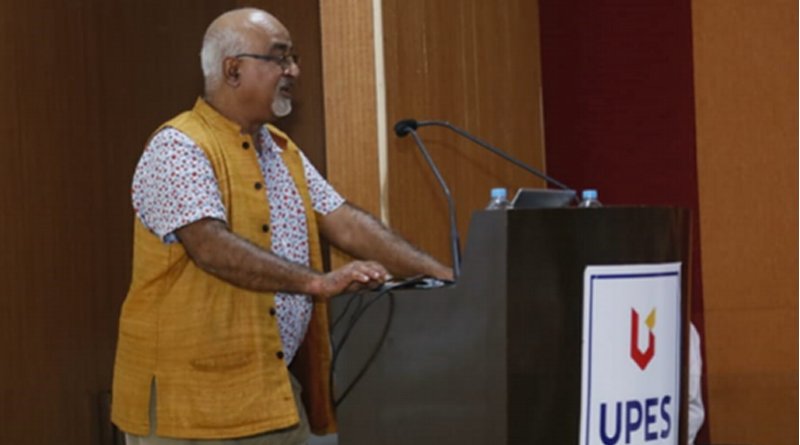India’s Spatial Development And Growth Challenges: A Report On Lecture By Dr. Ejaz Syed Ghani, Lead Economist And Consultant, The World Bank
In India, the secondary cities like Dehradun are bound to become the center of development similar to that of Europe, US, China and other developed nations, opined Dr. Ejaz Syed Ghani, Economic Advisor at the World Bank (USA). He was addressing to the galaxy of academician and students in the conference on “India’s Spatial Development and Growth Challenges – with a focus on Energy and Transport Sector” organized by the Department of Economics and International Business, School of Business, UPES in the SoL Auditorium of Kandoli Campus, Dehradun, India.
Expressing his optimism on India’s potential to grow many fold, Dr. Ghani said that on account of attention to be adhered to spatial development, PM Modi has already emphasized over the importance of wealth creation. Bracketing India in late mover advantage cell , he stressed on the idea that as a latecomer of development, India has the potential to utilise new technology for futuristic spatial development. The facts and figures deduced today indicates that the coming decade will witness maximum growth rate in Service sector.
Dwelling at length on the drivers of Spatial development and Urbanization, he brought the concept of “pull” and “push” into existence. “The engines of growth initiate the journey in Mega cities but with the passage of time, the dole of growth shifts to the secondary cities” added Ghani.
He further maintained that spatial development is expected to flourish via the modes of Green Energy such as Tidal Power plants, solar panels, Hydro-electric power plants, windmills etc. Commenting on vision of the Government and policy makers, veteran economist put weight on the need of studying the constraints that are restricting the dream come to reality.
“Factors such as huge congestion cost, lack of adequate investment in infrastructure and gender inequality prevalent in these secondary cities are reducing the pace of better growth and development of the country. However, if these grey areas are dealt diligently, it will lead to unexpected positive results. It is well predicted that the slow growing secondary cities will gain more traction than the mega cities. Besides lack of infrastructure investment; poverty and slow pace of Human Development are the added factors that need to be addressed to accelerate growth rate,” enunciated Ghani.
Dr. Ghani further had opined that progress on social, human, and infrastructure development is mixed. Spatial development is spreading to intermediate cities without spatial convergence in health, child malnutrition, and gender outcomes. Therefore, slow pace of convergence on social/human/physical development could compromise 2030 Goals.
Citing his experiences from abroad, he highlighted the role of public private partnership as reservoir of economic funding and activity and said that following PPP model could lessen the burden on Annual Budget.
Summarising the thoughtful lecture, he made premonition about India’s double digit growth and ten million jobs creation, duly facilitated by the spatial development and further stressed on tapping into the Capital market “financing and banking sector is also a way to procure the necessary funds that are required. The focus should also be to adopt an approach of inclusive growth and development. Though the spatial development in India is at a nascent stage today, but with strong efforts and focus in the prominent areas will lead the country in the right direction.”
In his concluding remarks he highlighted that no high income country has become high income without urbanization, but not necessarily high urbanization will lead to high growth. While China’s urbanization has been unprecedented, in relative terms, at 50 percent of GDP it is somewhat lower than other countries of same income level, and “registered non-agriculture” population as low at 35 percent. Technically, it has to do with the nature of rural migration. Only 20 percent of rural migrants have migrated to cities with whole families, due to rigid social insurance regulation system. China’s urbanization is associated with the rise of secondary cities and rapid growth in manufacturing sector.
Urbanization has not been associated with service led growth. Urbanization patterns associated with service industry differ from that of manufacturing. Urbanization and industrialization coincides with a declining contribution of consumption to growth, including urban consumption’s share in growth and GDP has started to decline in recent years.
Going forward, the authorities understand that traditional model of growth that is based on investment and external demand is not sufficient, hence, a need to focus on policies that unlock domestic consumption, urbanization is viewed as a possible source of growth. The city infrastructure building and operation management, education and health, social security and low-income housing construction all depend on the indispensible support of fund.
Presently, quite a few problems exist in urban financing, including the lack of a fundamental supporting taxation and short of major tax sources for local governments; incompatibility between public service responsibilities that falls on the city government and the financial strength it possesses (with heavy debt burden); the transfer of payment from the central government to the local government seldom considers the factor of providing public services to immigrants; and the city infrastructure building relies too much on land transfer income. However, urbanization has helped to reduce inequality. Income gap between average urban and average rural is declining, but the ratio between “top” and “bottom” income levels is increasing in urban and rural areas. More recent data needed to make all these arguments more compelling.
Later the floor of house was also opened for discussion wherein certain relevant questions were raised and answered effectively. Prominent among others present on the occasion included Dr H Roy, HoD, Economics and IB; Dr. Narendra N. Dalei, Programme Coordinator; Dr T Dhingra, Assistant Dean Research; and Dr Vijay Singh, Dean School of Law, UPES.
*Dr. Narendra N. Dalei (Programme Coordinator), Distinguished Lecture Programmes, School of Business, University of Petroleum and Energy Studies, Dehradun (India)

